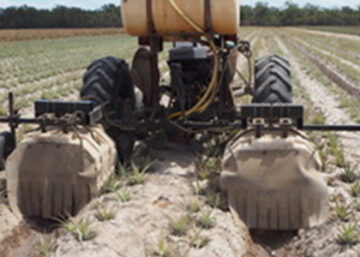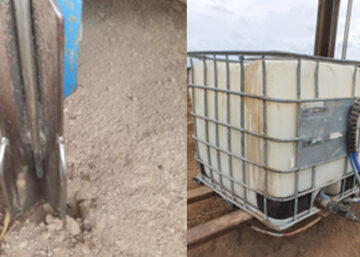
Research Topic 2: Ground preparation, fallow management
and
Research Topic 3: Pre- and post-plant nutrition management
Trial numbers: SA02WB-01 and SA03WB-03
A pineapple crop needs substantial nutritional requirements to effectively grow commercial yields. These nutritional requirements are required both in the pre-plant and post plant stages of crop growth. They consist of large amounts of macro elements such as nitrogen, phosphorus, potassium, calcium and magnesium, as well as small amounts of micro elements such as zinc, iron, copper and boron. Traditionally, the nutritional requirements have been met through inorganic fertilisers for example urea, potash, magnesium sulphate, etc.
Research undertaken by Cyril Ciesiolka from the Department of Natural Resources (DNR) in the 1990s indicated that there is a substantial amount of nutrition in the ratoon crop plants prior to crop destruction, for example 1.2 tonnes per hectare of elemental nitrogen and 1.6 tonnes per hectare of elemental potash. Each ratoon crop consists of approximately 130 tonnes of plant matter per hectare. This is traditionally destroyed by the grower using four to six passes with a rotary hoe which leaves most of the crop residue on the surface of the soil to breakdown. With this practice much of the nutrition and organic matter is not returned to the soil to be utilised by the next crop. By replacing some of the rotary hoe passes with mulching implements for crop destruction, better use can be made of the remnant nutrition in the plant residue by incorporating it back into the soil profile. Furthermore, incorporating organic compost, and growing and incorporating crop residue from fallow crops can further contribute to pre-plant nutritional requirements and supplement inorganic fertilisers.
In Australia the industry is located near the coast, often close to sensitive environmental areas such as the Great Barrier Reef and Moreton Bay Marine Park. It is also often grown on sandy soils that are prone to soil erosion. As well as potential environmental impacts there are also increasing concerns about rising fertiliser costs, so managing nutrient inputs has never been more important. The key issue of concern is off-farm deposition of nutrients, primarily nitrogen. High levels of nutrients in the water can have a negative impact on aquatic environments, for example by causing blue green algae blooms. It is important for pineapple farmers to manage their fertiliser programs efficiently and reduce losses of fertilisers from the farm. Measures include only applying amounts that will be used by the crop, reducing the movement of water across the farm and as far as possible retaining applied nutrients on the farm so they are not contaminating the environment.
This demonstration trial focused on comparing traditional crop destruction practices against the integration of mulchers to better manage crop residue and its nutrient content. It also looked at the effects of adding compost and additional biomass from fallow crops.
OBJECTIVE
Supplement pre-plant inorganic fertiliser requirements and improve soil health through:
- Improving release of nutrient back into the soil profile from better incorporation of residue from the previous crop using a mulcher.
- Planting break crops in the fallow period then incorporating them into the soil.
- Incorporating compost into the soil profile.


